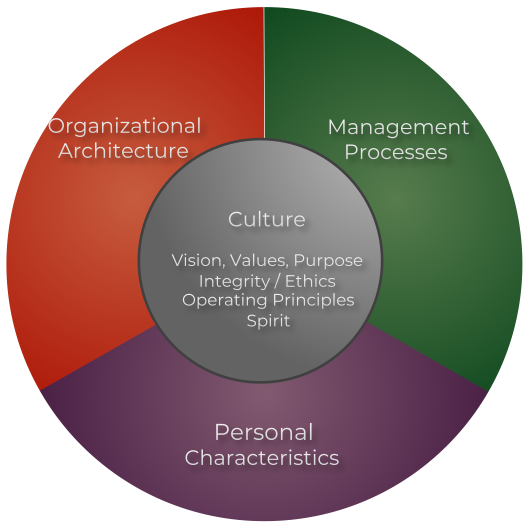Identifying Middle Management Training Needs
As you begin planning a leadership development program for your mid-level managers, identifying middle management training needs can be tricky. There are so many potential areas to focus on, so many different approaches on the market for improving your organization, training your leaders, developing innovation and the like. Where to even begin?
In order to simplify the process of identifying middle management training needs, Hallett Leadership uses a map called “The Culture Flywheel.” See below:

The three zones within the Flywheel are Organization, People, and Processes.
While the three sections of the Culture Flywheel are of equal importance, the “People” zone must be addressed first in order to make effective changes to “Organization” and “Processes.”
Think of the process of leadership development as a ship’s voyage across the open ocean. You could have a great ship (organization) and a first-class map (process), but if the people on your crew aren’t committed to the mission or each other, you aren’t likely to reach your destination.
Therefore, our leadership development journey begins with the crew…
Your People Form The Foundation Of Lasting Organizational Change
There are many labels for a workforce that is not operating at a high-performance level. At least as many as there are leadership development approaches. Are your people familiar and friendly with each other, but limited in their willingness to push beyond the status quo? Or are they hyper-motivated, but only for themselves or their individual departments?
No matter how many labels there are for non-high performance teams, and however your team shows up in your workplace, our experience has shown that the remedy begins here:
Alignment.
Of all middle management training needs, the first is getting people into alignment.
How do we do that?
Encourage Your People To Share Their Perspectives
For starters, we cannot mandate alignment. Alignment is achieved through the consent and willingness of individual stakeholders, whose participation is as emotionally-driven as it is rationally-driven.
Invite your middle managers and emerging leaders into the same room, and ask for their thoughts on where the company should go, and what they would like to experience as members of the organization. Ask for their input on what kind of culture they would like to participate in.
However you do this, the key is to communicate to your middle managers through listening that you value their voices, and that they have a seat at the table. This will elicit trust and develop each contributor as a stakeholder in your organization.
Also, keep in mind that everyone has their own style of perceiving and communicating, and that the more reserved or cautious among your developing leaders may benefit from a little extra encouragement to speak up and share their perspectives with the group. Every group is different – just be mindful to make sure everyone gets air time.
Guided By A Common Vision
Your leadership development goals at this stage should prioritize open and trusting relationships among your middle managers, and facilitating feedback exchanges so the group can dissipate any tension and conflict that naturally build up when people of different perspectives and opinions come together to collaborate.
Through this process of exchange, communication and collaboration, have your group articulate a common vision for the company. Please note, that this would not be a vision based on performance goals. That can come later. First, have your people collaborate on creating a vision for what kind of culture your team wants in your organization. Then build strong alignment around that vision.
A common vision sourced from a group of people is highly likely to create alignment among them. Then senior leadership may leverage their aligned workforce as a foundation to build upon.
It is also worth mentioning that as developing leaders become aligned with each other and begin to develop the habit of collaborating, some team members may not adapt, and you may need to make some personnel changes to continue fostering and deepening alignment inside the company.
Or perhaps you are discovering that previous incentives are not working very effectively, and that it is time to implement new incentive structures that align better with the overall vision.
With a vision sourced from your emerging leaders who work day-to-day in the trenches of your company’s operations, you have built a strong foundation for alignment.
Now, with an aligned workforce and developing leaders driving collaboration across departments, you can effectively tend to the two other areas of the Culture Flywheel – Organization and Process.
Approaching Organizational Modifications
Now that your people are aligned around a common vision, everyone in your organization begins moving in the same direction. There is increased communication and an increased willingness among your developing leaders to consider other areas of the company outside of their specific focus, and to proactively engage their peers from other departments for input and ideas.
Invite Your People To Brainstorm Organizational Modifications
It is highly likely that some aspects of your organizational structure are not an optimal match for the new culture of collaboration and aligned action that is developing among the ranks of your middle managers.
At this stage, it is time to invite your developing leaders to brainstorm ideas for organizational modifications that would facilitate collaboration among different departments and horizontal communications between different verticals of the organization.
By way of example, let’s discuss an organizational innovation that one of our middle manager training cohorts developed during their Accelerated Leadership Program (ALP) at Fox…
A Winning Organizational Innovation Initiated By Developing Leaders
Citing the need for increased collaboration and communication on all films and shows, at every stage of their journey through production, marketing, and distribution through all channels, the ALP participants noticed that the studio’s method of treating a film like a relay was no longer effective.
When theatrical production passed a film to theatrical marketing, theatrical marketing might have a list of items they wish had been tended to during production; home entertainment might in turn have wished theatrical marketing was more inclusive before handing off the project to them, and so on.
The middle managers in the ALP program recommended forming a task force comprising representatives from several studio divisions to meet prior to a film entering production in order to determine the life cycle of the intellectual property being developed, including what would be needed by each group, who would be the target audience, and other relevant strategic guidelines.
This innovation in the structure of the organization was a tremendous aid to reinforcing interdepartmental collaboration at a cultural level. Hence, a collaboration habit begun in a room with a group of courageous, talented young leaders who were willing to suggest something new, was able to develop into an enduring organizational cultural trait that positioned the studio for great success in the following years.
An organization that aligns its people and implements processes to support the functioning of a new organizational culture becomes nimble and capable of responding quickly to changes in the marketplace and regulatory environment. In addition, such nimble and responsive cultures are even capable of initiating and driving new changes in the marketplace and regulatory environment themselves.
Developing Processes To Support New Organizational Structure & Mid-Tier Leaders
Your people are aligned, and working together like never before. You have sourced recommendations from them for organizational changes to foster greater levels of collaboration. They have rearranged the deck chairs, so to speak…
Now it is time to orchestrate new processes so that people don’t trip over the newly arranged furniture.
Ask Your People! (Once More)
Just like the previous stage when the group was brainstorming organizational adjustments to facilitate collaboration, bring the group together again to diagnose their needs in terms of processes that facilitate aligned action.
As with any process of implementing something new, there will be a period of trial and error. Fortunately, an aligned group of people often have the enthusiasm and clarity to take on challenges together, and where difficulties arise, will take time out to exchange feedback with each other.
Creating new processes may require adopting new technology or communications platforms to facilitate collaboration. Challenge the group to generate their best ideas among each other, and adopt what appears to be the best solution, given the time and the amount of information at hand.
Robustly communicating work teams with nimble processes are best positioned to leverage emergent technologies and keep your company competitive.
Conclusion
We hope the Culture Flywheel and it’s three elements will be a valuable tool for developing your next generation of leaders. At the heart of it all is this:
Get your people who work in the trenches to collaborate and communicate, be honest with each other, and align around a shared vision. Once they’re fully aligned, build your organizational structure and processes around them. Without an aligned, collaborative team, successfully implementing new organizational structures and processes is way too hard.
Hallett Leadership is on hand to support the development of your next generation of leaders. Please feel free to reach out.





